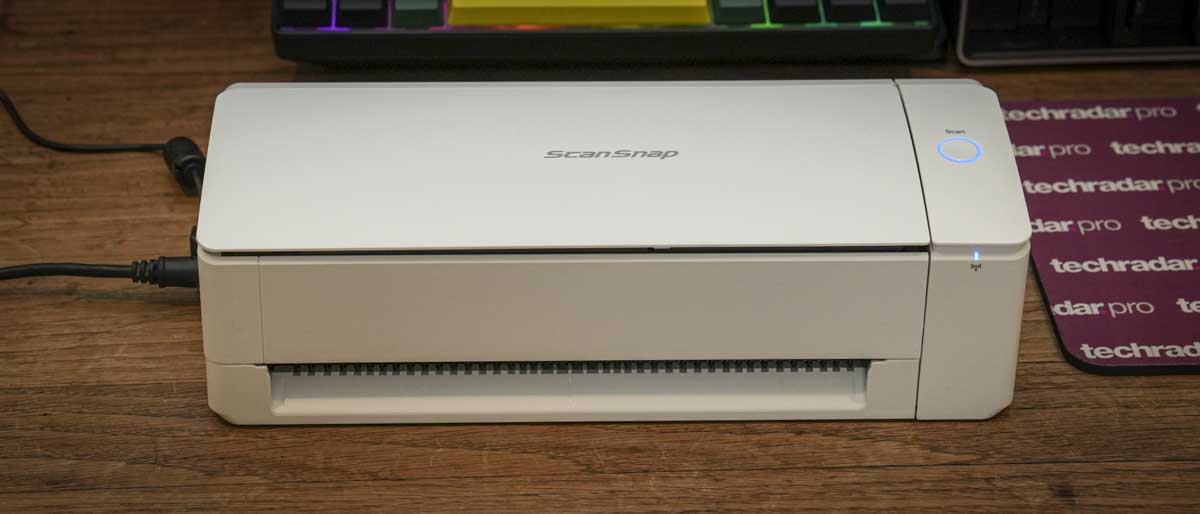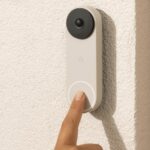Why you can trust TechRadar
We spend hours testing every product or service we review, so you can be sure you’re buying the best. Find out more about how we test.
ScanSnap iX1300: 30-second review
I love the concept of the ScanSnap iX1300. It’s essentially a small auto-feed desktop scanner designed for home or small office use, and from the outset, it’s instantly apparent that it’s far removed from standard flatbed scanners, which rely on placing each individual document on the scanner to create a digital copy.
The iX1300 offers several scanning options using the ScanSnap Home software, which, while I found it lacks the design flair of many consumer applications, does reflect the power of its business-orientated use.
Unlike flatbed scanners, you can put a stack of A4 documents into the feeder at the top of the machine. Then using its innovative U-turn mechanism, it feeds each sheet through the system, scans it, and pulls it back out, neatly stacking the documents parallel to the feeder. This all helps to maintain a small desktop footprint.
The top feed is superb for documents and small quantities of photographs, accepting up to 20 sheets at a time, which should be adequate for most small offices. If you need to scan a batch of photographs, you can also do so, although the scanning quality is more suited to documents rather than high-quality imagery.
The design of this small scanner is exceptionally neat. I found that the Wi-Fi and USB connectivity enabled plenty of flexibility over the positioning of the scanner. Its slimline design enabled it to sit beside my monitor without dominating space and then when not in use, I could fold down the lid, further decreasing the footprint.
In my home office, where desk space is tight, I found using the Wi-Fi connection a great option, enabling me to place the iX1300 on a shelf, plugged into power, where it sat ready and waiting to go. I could then scan the documents in the same way as when the machine was by the side , although now the files were wirelessly sent to the cloud or a folder on my machine.
The physical design is difficult to fault. In addition to the top-loading auto paper sheet feed, there’s a front slot for feeding documents that are not suited to the U-turn mechanism; here documents that are longer than A4 and objects up to 2mm thick can be fed in and scanned.
In use, the scanner performs exceptionally well, feeding 20 sheets quickly. You can choose document types, create searchable PDFs, or save files as standard PDFs or JPEGs. You can also upload to Google Drive or other cloud services, making it easy to scan and share documents.
The ScanSnap Home software helps you sort and organize files and while the design of the software looks a little dated, there’s no doubting the application’s functionality. While the iX1300 has limits—the 20-sheet capacity and moderate photo quality—these are all in balance for its intended use, offering speed and ease of use that make it one of the best scanners for office document scanning.
ScanSnap iX1300: Price and availability
- How much does it cost? From $249 / £249
- When is it out? Available now
- Where can you get it? Directly from Rioch or Amazon.com
While standard flat scanners can cost under £50 and offer high-quality image scanning, the ScanSnap iX1300 must offer a lot to justify its £249/$249 price tag. Its speed far exceeds that of flatbed scanners, and its functions suit a busy office better than a relaxed home environment. This scanner is available directly from Ricoh or from online retailers like Amazon.
ScanSnap iX1300: Specs
Scanner Type: Dual Path, Automatic Document Feeder (ADF) + Single Feed (Return Scan), Duplex
ADF Capacity: 20 x A4 80 g / m², 20 x Letter 20 lb
Scanning Colour Modes: Colour, Greyscale, Monochrome,
Automatic Detection: (Colour / Greyscale / Monochrome)
Optical Resolution: 600 dpi
Image Sensor Type: CIS x 2 (Front x 1, Back x 1)
Light Source: 3 Colour LED (Red / Green / Blue)
ScanSnap iX1300: Design
Taking the iX1300 out of the box, it’s immediately apparent that this scanner is different. Unlike the flatbed scanners I use at work for documents and photographs, the iX1300 footprint doesn’t even meet the dimensions of a sheet of A4 paper.
Opening the lid reveals an ingenious U-turn mechanism that feeds paper in, scans it, and returns it to a tray parallel to the original feed, all meaning that the machine takes up far less space than most home or office scanners.
The neat design stands out when compared to other scanners, with Ricoh clearly considering office aesthetics. Available in pure white or optional black, it looks stylish and more like a compact printer than a scanner.
Setup is quick and easy and at 296 x 114 x 87mm and weighing 2kg, it’s easy to position and while compact, it has enough weight for stability during high-speed scanning. Testing on both a MacBook Pro M1 Max and an Intel NUC 9 Ghost Canyon, I was pleased that in both cases the setup was straightforward.
The ScanSnap Home software installed easily on macOS and Windows, connecting via USB before offering a step-by-step guide through general as well as Wi-Fi setup.
Once set up, the feeder tray supports up to 20 A4 sheets or other documents. Documents are fed through the system round the U-turn mechanism, where they’re scanned, single- or dual-sided, and then returned.
For items that can’t be bent, like older photographs, the iX1300 offers a front slot. It automatically grips documents up to 2mm thick and again can duplex scan both sides in one go.
Once everything has been set up and a home found on my desk, getting started with scanning documents all proved to be fast and simple. The ScanSnap Home software automatically collated scanned sheets into a single PDF, streamlining the process.
ScanSnap iX1300: Features
The ScanSnap iX1300 is designed for the home or small office, offering a compact design and an automatic document feeder (ADF). You can stack up to 20 sheets of A4 paper, which will be automatically scanned at up to 30 pages per minute.
Another headline feature is the return scan slot, which is designed for plastic cards, receipts, and bifold A3 documents and, again, like the main scanning mechanism, offers duplex scanning, essentially the scanning of both sides of the document at once.
One of the features that I like for the simplicity is that there is no dedicated on/off button. Opening the lid powers it on, and as you do so, the document feed extension automatically extends. Closing the lid powers it down. You can also feed documents into the return scan slot to wake the scanner.
Any worries that the small size would affect its functionality were quickly dismissed as I started to use the scanner and I actually found that the features helped to make it extremely versatile, and the fact that it took up minimal space even when the feeder and tray are extended just ensured that it was left out ready for use, unlike my usual scanner, which, while small and thin, gets packed away when not in use.
Another of the features that I really liked is that fact that it works across Windows, Mac, and Chromebooks and supports iPad, Fire Tablet, iPhone, and Android devices. Then there’s the ScanSnap Cloud that, through the test, enabled integration with Google Drive and is compatible with other cloud services.
At the heart of the iX1300 is the ScanSnap Home software. While the interface of this looks a little dated, it works incredibly well and enables you to scan, edit, search, and organise files really easily.
ScanSnap iX1300: Performance
Getting started with the ScanSnap iX1300 was easy enough, and once everything was installed and set to go, I began by placing some bills and bank statements into the scanner. One of the features I really liked was being able to use the automatic document feed so I didn’t have to lay them out sheet by sheet on my flatbed scanner.
This is where the ScanSnap iX1300 really starts to become impressive and well worth its price tag. For example, I placed a bank statement with five sheets into the feeder. I selected the option to continuously scan all sheets in one go and opted for duplex scanning, so it scanned both front and back. When I hit scan, the sheets were fed very quickly through the scanner—in less than 10 seconds—and within a few more seconds, a PDF appeared in the ScanSnap Home software with all of the sheets combined into a single PDF.
This PDF was extremely useful and meant I could shred the bank statement and have a digital copy for my records. Although these days we have online banking, which in most cases eliminates the need to scan paper bank statements, there are some bank accounts and documents that still use paper. Once the documents were scanned, the next step was to right-click on the PDF in the ScanSnap Home software and convert it into a searchable document.
Once converted, I could open the document in Word or another application, where it was fully editable. Likewise, if I wanted to use it as a searchable PDF, it worked perfectly.
During testing, I scanned multiple documents, including some legal papers I needed to review for certain clauses. The fact that I could quickly scan these paper documents, convert them into searchable files, and search through them again helped reduce the time spent reading through multiple sheets trying to find the needed paragraph.
This initial use was exceptionally fast and effective for straightforward A4 document scanning. Just for this single feature, the ScanSnap iX1300 already seems like an essential tool for any home office and especially mine.
I then considered my business needs and all the different paperwork I often handle—model release forms, health and safety forms, equipment rental forms, and various other documents needed for photo and video shoots. I could scan each folder, and in seconds, all documents were digitised and searchable. This meant that if I needed to scan the documents to see, for example, the location of camera two and who was responsible, the information was quickly available.
The other major part of my work involves administrative tasks after the practical side of a photo or video shoot. This often includes documenting health and safety forms, risk assessments, and correlating business expenses and receipts, then matching those against Xero accounting software.
Ordinarily, I use my mobile phone to photograph receipts and connect them to Xero at the time of purchase. However, this doesn’t always work due to time constraints and being busy. Instead, I often stuff all the receipts I collect throughout the day or week into a zipped pocket in my camera bag. Usually that’s where they stay until I have a dedicated administration day.
With the iX1300, I was able to feed all these receipts through the front slot on the return scanner and quickly perform duplex scans of each receipt before uploading the JPEG files to Xero to link with expenses. This process, while a bit more manual, was much faster than using my phone to photograph shaky pictures of receipts. Once again, another functional feature of this document scanner that really stood out.
Throughout using the ScanSnap iX1300, I was generally impressed with its functionality and usability. My only slight reservation was the ScanSnap Home software UX design, which just looks dated. It looks like office software rather than having the elegant design typical of home applications. However, it provides all the valuable data needed and is highly usable and easy to navigate.
It would have been nice if the software also allowed you to convert documents—say, production documents into Word or equipment forms into Excel—directly from within the software. In most cases, though, you can convert them to searchable PDFs and then into Word, at which point most documents become fully editable.
As I work in the photography sector, another feature I would have liked was better photo scanning. I loaded a series of 6×7 prints into the automatic document feeder, and while it was able to scan a decent number of standard photos, the results were not especially high-quality. Even at the highest quality setting, image contrast seemed a bit excessive, and there was some detail and tonal loss. However, for office use, such as scanning site photos, this scanner is ideal. If you’re thinking about scanning 35mm or 6×7 prints at high quality, a dedicated photo scanner would be much better.
When it comes to day-to-day office tasks, the ScanSnap iX1300 is a superb office tool, helping to speed up workflow for administration and archiving valuable business documents.
ScanSnap iX1300: Final verdict
The ScanSnap iX1300 should be seen as an office essential. Its small size makes it especially convenient, particularly in mostly paper-free offices where occasional scanning is still required.
The small size through the test enabled it to sit comfortably on my desk, ready to use, and with the Wi-Fi features, I had the option to pop it on a shelf, plugged into the AC mains, but ultimately out of the way. Scanning is fast and easy, using the U-turn mechanism for single or duplex scans, which also enabled it to save space with that small footprint.
The 20-sheet limit on the autofeed is really due to the space, but still through the test I found this to be more than enough for all personal and business use. The return scan feeder also adds a little more flexibility for scanning plastic cards, business cards, and other non-standard materials.
While photo scan quality is limited, the iX1300 excels at document scanning. It also automatically corrects skewed documents and offers paper guide adjustments for improved scan quality, which, in use, I found made a major difference to the overall quality of scanning.
For any office, whether at home or a small business, this scanner can save hours compared to using a flatbed scanner.
Should I buy a ScanSnap iX1300?
|
Value |
The scanner is expensive compared to a flatbed but well worth it |
4.5/5 |
|
Design |
Compact design with innovative features that make it incredibly fast and versatile |
5/5 |
|
Features |
Auto sheet feeder, return document scan, and cloud compatibility offer great value |
45/5 |
|
Performance |
Not designed for high-quality photos but excels at document scanning |
4.5/5 |
|
Overall |
If you regularly scan documents, you should buy the ScanSnap iX1300 |
5/5 |
Buy it if…
Don’t buy it if…
For more options, we’ve rounded up the best scanner deals around.
Read the full article here













